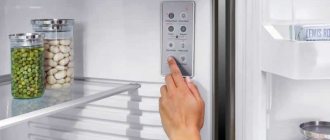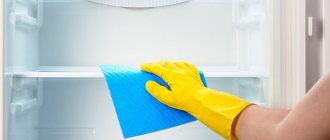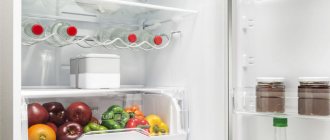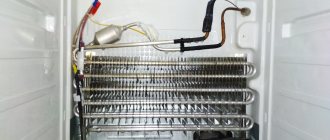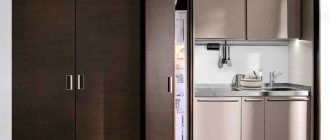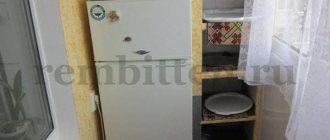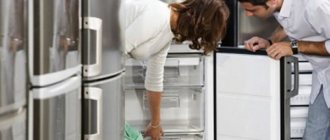A refrigerator is a serious and expensive purchase. Usually, due to life experience, people are aware of the rules for its operation. But for some reason, not everyone knows that you shouldn’t immediately connect it and load it with products. Before using it for the first time, the refrigerator must be washed.
After purchasing a new refrigerator, be sure to wash it before using it.
How to clean a new refrigerator before first use?
There are a number of factors that speak in favor of washing.
- A new household appliance, fresh from the factory, has a specific smell, you can call it “technical”. Washing helps prevent food from absorbing this dubious aroma.
- In the production of household appliances - after all, this is not the production of medical equipment and food - strict sterility requirements are not met. A brand new unit may look clean, but in reality there may be dust and various contaminants on its internal surfaces.
- The item did not arrive at the store’s sales floor immediately from the workshop - it happened to be in a production warehouse, perhaps even two - large retail outlets and centers also have their own warehouses. During transportation and storage, dust and microparticles of dirt settled on the device - after all, its packaging is not vacuum.
To eliminate the specific odor, the new refrigerator must be thoroughly washed.
Washing the device after these adventures is a normal hygienic requirement, a necessity. How to wash a unit equipped with a “No Frost” system, and is this treatment different from washing a regular refrigerator?
See also “Freshness zone” in the refrigerator - what is it?
Does a new refrigerator need to be washed?
Before stocking the shelves with food and plugging in the appliance, you need to thoroughly wash it, or even better, disinfect it. There are several reasons for this:
- The production of refrigerators does not require sterile cleanliness; even if there is no external contamination, there is dust and particles of plastic or metal invisible to the eye inside. They settled at the joints of the parts of the device and probably ate into the porous structure of the rubber seals.
- The conditions for transporting and storing the refrigerator in a warehouse are also far from ideal. In particular, during transportation there is a high probability that all kinds of particles of harmful substances found in vehicle exhaust gases that are dangerous to the body will settle on the device.
- A refrigerator displayed in a sales area is also susceptible to contamination. After all, it is unknown how clean the hands of the worker who installed the device in place and the clients who looked at it before you were. And if one can at least hope that store employees undergo a medical examination and are not ill with anything contagious, then nothing is known about the health status of store visitors. But you are going to store food in the refrigerator.
- Unfortunately, wanting to get the maximum benefit, some manufacturers began to use low-quality materials, most dangerously cheap plastic. In addition to the obvious harm, it can emit an unpleasant odor that is almost impossible to get rid of. If you missed this point when purchasing (perhaps the sellers used flavors or fragrances to mask this defect), then after washing the presence of the smell will be obvious, before you start using it you can return the device to the store.
The conclusion is obvious - you need to wash it!
For high-quality cleaning, use the following algorithm:
- Check if the device is unplugged.
- Use a dry cloth to clean the refrigerator from dust and dirt particles.
- Prepare a washing solution: add the required amount of your chosen product to a bowl of warm water (if it is a household chemical, information on use is on the label), stir or foam it.
- Dip a sponge or soft cloth into the resulting solution and thoroughly rinse not only the refrigerator and freezer compartments, but also the outer surface. Particular attention should be paid to the grooves, doors, all kinds of trays, drawers and containers of the device. Be especially careful with rubber seals; they are easy to damage and difficult to replace. Don't forget to protect your hands - wear rubber gloves.
- Change the water to clean water and rinse the refrigerator, not forgetting to change the rag.
- Wipe the refrigerator with a dry towel and leave open until completely dry.
Features of cleaning the chamber with the “No Frost” system
The most important element in the operation of the “No Frost” chamber is the ventilation system. Its blockage can lead to disastrous consequences, including failure of the device. The first thing you should do is clean the ventilation holes in both chambers - the freezer and refrigerator. To process them, you will need cotton swabs and clean water at room temperature or a weak soda solution. The holes must be processed very carefully. External panels can be treated with chemical cleaning agents, with the exception of abrasive ones that can scratch the surface.
I start cleaning Refrigerators operating with the No Frost system from the ventilation holes.
Important! It is forbidden to remove the panels covering the ventilation. You violate the terms of the warranty agreement with the device manufacturer, and in the event of force majeure (incorrect operation of the device, breakdowns) you lose the right to free repair work.
See also “no frost” technology in refrigerators.
Instructions for cleaning the refrigerator
Washing household appliances with a drip defrosting system and the No Frost function is slightly different. But the preparation measures and the list of cleaning tools are the same for all models.
Preparation
Before using it for the first time, you should wash your new refrigerator when it is completely ready to be turned on. It is installed in place, the legs are adjusted in height.
Make sure that there are no parts or foreign objects in the chambers that were not used during installation. All pull-out shelves and drawers are removed. If there is a protective film on any elements, it is removed.
What you will need
For processing, you will need detergents and cleaners, a bucket, water, and soft rags. Do not use metal sponges or rough rags. To clean refrigerators with a drip defrosting system, you need cotton swabs, knitting needles or similar items.
To protect your hands from chemicals, you can equip yourself with gloves.
To prevent water from leaking onto the floor, it is covered with rags. You should also make sure there is free space to wash off dirt from shelves, trays and other removable parts.
Cleaning step by step
Regardless of the model, the device is washed first inside and then outside. Manufacturers may place a sign intended for service personnel. It is usually attached to the inner wall of the refrigerator compartment.
It must not be damaged, destroyed or removed; you must be especially careful when cleaning.
Models with No Frost system
Models with the No Frost system do not have a drainage hole to drain melt water, so you just need to thoroughly wipe all the internal walls and accessories:
- Wash all shelves, drawers in the sink or bathtub, like dishes, wipe them and set them to dry.
- Lock the chamber doors in the open position.
- Dilute the detergent in a bucket of water.
- Dampen a rag or sponge in the resulting solution.
- Wash the inner walls, moving from top to bottom.
- Change the water and use a clean damp cloth to remove the product from the washed surface.
- Wipe dry.
- Dilute door cleaner on the outside and wash them.
After this, you need to leave the refrigerator with the door open for at least an hour so that it is well ventilated.
Refrigerators with drip defrosting
In a refrigerator with drip defrosting, pay special attention to the drainage hole:
- Use cotton swabs or similar items to clean the drainage hole, which is located at the bottom of the rear wall of the refrigerator.
- External and internal surfaces are treated in the same way as for refrigerators with the No Frost system.
It is necessary to wipe the new refrigerator with a drip system before turning it on so that water with the product does not get into the drainage hole.
After washing, the device, regardless of its model, needs to dry. Even if the refrigerator is wiped dry, manufacturers recommend letting it stand for 12-24 hours with the doors open and turned off. Then they put in removable shelves and drawers, load the products and start it up.
How to clean the inside of a regular refrigerator
In this case, it is allowed to use both available household and chemical cleaning products for washing, using them in accordance with the manufacturer’s instructions. The similarity with the “No Frost” wash is that it is also not recommended to use abrasive powders. This is especially true for cleaning the freezer.
To clean regular refrigerators, you can use household chemicals.
See alsoCleaner for glass ceramics
Chemical cleaning products
The range of chemicals for cleaning refrigerators is quite wide. You can find it in any store or household chemicals department.
Now we’ll tell you how to use refrigerator cleaning products:
- It is necessary to dilute the detergent with water and apply it to all surfaces inside the refrigerator;
- after chemical treatment, thoroughly rinse all shelves and trays with clean water;
- Now you can wipe the inside of the refrigerator with a dry towel;
- Leave the door open for several hours to thoroughly ventilate your new refrigerator from chemical and plastic odors.
Recently, all kinds of cleaning pastes for refrigerators have become popular, the peculiarity of which is that they have a creamy texture and do not contain abrasive particles.
We proceed with pastes as follows:
- apply any of them to all surfaces inside the refrigerator;
- after applying the cleaning cream, thoroughly wipe all shelves, trays and walls of the refrigerator compartment;
- rinse with plenty of water and wipe dry;
- It is advisable to do this procedure in the evening so that the refrigerator is thoroughly ventilated overnight.
Choosing detergents
How to clean your new refrigerator is up to you. The choice is a matter of personal taste and preference. A well-maintained unit can be seen in homes where “grandmother’s” traditional cleaning methods are used, and in the most modern high-tech kitchens, where special chemical compounds are used. An indisputable argument in favor of traditional methods is an allergy to household chemicals in the housewife or her family members.
If the housewife is allergic to chemicals, then you can use folk remedies to clean the refrigerator.
See alsoDesign for a billiard room, photo.
Household chemicals
Today, a considerable number of specialized hygiene products for refrigeration equipment are produced. Popular forms of release are spray foam, liquid, gel. They are preferred because of their effectiveness and properties: usually these household chemicals have an antibacterial effect, they can be used to wash even old stubborn stains, and they are suitable for both indoor and outdoor washing. Depending on the manufacturer, the cost of these goods varies.
Household chemicals are used to clean internal and external surfaces.
Products of expensive well-known brands:
- Electrolux E6RCS104 (in the form of a spray liquid, made in Italy).
- WPRO FRI 00 (a similar option, also made in Italy).
- Topperr 3104 (refrigerator care kit consisting of cleaning agent, microfiber cloth and odor absorber based on activated carbon granules, made in Germany). At a significantly lower price, you can purchase the spray separately.
Budget options.
- Clean Home (universal washing gel, domestic manufacturer).
- Selena (spray liquid, made in Russia).
- “Clean refrigerator” from Luxus (with aromas of lime, grapefruit, mint. Sprayable product, Russian production using German technology).
For washing, you can use Russian and foreign detergents.
Between expensive and inexpensive brands there are many mid-priced items. Before using as directed, you should study the manufacturer's recommendations for use on the label.
Important! Manufacturers claim that their chemical masterpieces do not require a final wipe down of the refrigerator, since they do not contain substances that are toxic to humans and can be absorbed into food. But it’s better to use clean water - we can assume that there really are no toxins, but allergens for specific people may be present.
At the end of washing, you can wipe the surfaces with plain clean water.
See alsoCorrect kitchen design 9 sq. m: what's the secret?
Why is it necessary to thoroughly clean the surface before using it for the first time?
Loading with products and turning on a new device - these actions must be preceded by high-quality cleaning of the equipment from dust and unpleasant odors.
The reasons for this are obvious:
Transportation from the production workshop to the buyer
Before getting into your kitchen, the refrigeration unit has gone through a long transport route:
- it was delivered to the store from the manufacturer’s warehouse;
- first in the warehouse, and then in the sales area of the store, the equipment stood for an unknown amount of time, it was opened and looked through by thousands of hands;
- then they brought it to the buyer’s home and carried it to the final installation location.
At each of the indicated stages of its journey, the refrigeration unit was not hermetically sealed, i.e. exposed to dust, dirt and other elements. Therefore, a new refrigerator must be washed thoroughly both outside and inside.
Technical features of production
There is no high level of sanitation at the manufacturing plants of refrigeration systems, because... They produce non-food products here. Starting from the metal processing shop, going through many automated lines and a list of technological operations, processing with a special polymer coating and powder paint - this is how equipment parts are produced. More than 40 lithium machines produce refrigeration trays, lids, panels, and baskets. In the plastics shop, interior cabinets and interior door panels are made from polystyrene. Then the elements are assembled in the assembly shop and sent to the testing station. The final stage: equipping with shelves, vessels, containers and packaging the assembled equipment in corrugated film/corrugated cardboard for delivery to stores.
After such a process, it is stupid to talk about the absence of harmful substances, dust, microbes, and technical odors on its internal and external surfaces. To the question: do you need to wash a new refrigerator inside and out before turning it on for the first time? The answer is clear. Yes!
Folk remedies
If the housewife or her household have allergic reactions to the smell of chemical compounds, you should find out how to properly and cleanly wash a new refrigerator using improvised means.
For the first method you will need:
- regular baking soda;
- clean, room temperature water;
- sponge or cloth;
- towel.
How to prepare a cleaning solution: stir 2 (if the refrigerator smells strongly - 4) tablespoons of soda in a liter of water. The entire process will require (depending on the size of the device) approximately 5 liters of water. After finishing the sanitation, thoroughly rinse the sponge or rag or take a clean one - and remove the remaining soda.
If you are allergic to chemicals, you can use regular soda.
A soap emulsion will remove dirt just as effectively as soda - to get it, grate a little laundry soap (you can use soap), add water and create a soap solution.
For the second method, the same water and sponge will be useful, but take the famous home odor remover - vinegar. Two tablespoons per 1 liter of water is enough.
Vinegar is a universal odor eliminator.
Both cameras can be washed with both products. After washing and wiping clean, thoroughly dry the entire interior of the device with a towel. If necessary, allow to dry on its own.
Important! Do not wipe rubber gaskets with vinegar solution to avoid drying out and deterioration.
See alsoRussian stove in the interior - a unique design of a modern home
Preparing for washing
A refrigerator has been brought to you. The first thing you need to do is look inside. The refrigerator and freezer compartments may contain items that are completely unnecessary for further use. We are talking about packaging materials - film, foam spacers. Throw away this trash.
Gather all the items needed to sanitize the unit so you have them on hand:
- rubber household gloves to protect the skin of the hands;
- sponges, napkins or clean cloths;
- a clean, dry towel to remove excess moisture;
- the entire set of selected means - traditional or chemical;
- if you need to make a solution, prepare it.
A sponge, rubber gloves and household chemicals are all you need to clean the refrigerator.
See alsoFeatures of surface finishing with decorative stone
Washing technology inside and out
How to effectively clean a new refrigerator before use? Regardless of the cleaning composition used, care will be required to treat the refrigerator: its design features are such that you will have to pay a lot of attention to the little things (for example, poorly washed drawer corners may still emit an unpleasant odor). It's better to go according to plan:
- Remove all removable elements from the chambers - shelves, drawers, trays, side pockets and other components. It is better to wash them with detergents under running water in order to accurately wash off not only dirt, but also any remaining product. Don't neglect corners and recesses. Dry all elements thoroughly or wait until they dry naturally.
- Wash the chamber walls from top to bottom.
- Be sure to check the drain hole (it is located on the back wall) - very often the strongest smell comes from it. It can be washed with a syringe or a medical rubber bulb by pouring a washing solution into the channel.
- Cleaning the rubber seal can be successfully done using an old toothbrush.
- Once the inside of the appliance has been washed, wipe it dry and leave the door open to allow the walls to dry completely.
- Wash external surfaces using the same product. Slightly move the device away from the wall and inspect the back wall. If it is very dusty, remove the dust with a vacuum cleaner.
- Return the components to their original locations.
- After 6 hours, you can connect the device to the power supply and fill it with contents.
- If the technical smell is still noticeable, wipe the inside of the unit with a sponge with a solution of vinegar or citric acid. After this, wait 4 hours before turning on the device.
We start washing from the walls of the refrigerator chambers.
Important! All containers and packaging loaded into the chambers must be clean and dry on the outside - the chambers should be taken care of. There is no need to help the formation of an extra layer of ice in the freezer and increase the humidity level in the refrigerator compartment.
See alsoCorner shelf for the kitchen, features of choice and installation methods
Detergents
You can wash a new refrigerator before using it for the first time using folk or professional means. If detergent is included in the kit, then you need to carefully read the instructions. This product is almost always intended only for internal walls and plastic. External surfaces are cleaned with universal household chemicals or traditional methods.
Household chemicals
Refrigerator cleaning products differ in composition and form. They can be intended for all surfaces of a household appliance or only for internal walls.
The chemical industry produces products based on, in addition to anionic surfactants, the following:
- Alcohol has an antimicrobial effect. The popular sprays Sano Refrigerator Cleaner, “Clean Refrigerator”, and Topper have been developed on its basis.
- Alcohol and hydrogen peroxide - whitening is added to the antibacterial effect. This group includes Clean Home spray and Selena gel.
- Solvent - helps active substances to better adhere to dirt, which ensures cleaning of old and stubborn stains. The most common spray is Unicum.
Even a visually clean refrigerator must be washed before turning it on for the first time. But for this you can use softer means - with the addition of cationic surfactants.
They weaken the anions and prevent the aggressive effect of the product on the device. For example, Frigo Care from Electrolux. Compositions based on plant extracts also wash more gently. But before you wash your new refrigerator before using it for the first time, you need to make sure that it does not contain substances prohibited by the instructions.
Traditional methods
There is still no substantiated data on the effects of certain substances on refrigerator surfaces. Thus, instructions from manufacturers almost always prohibit washing equipment with a vinegar solution. Housewives often neglect this rule.
The refrigerator continues to work. But there is no guarantee that vinegar did not cause microdamage to the walls. And this can later give impetus to the onset of undesirable processes: corrosion, mold formation, etc. By choosing a cleaning method that is not permitted by the instructions, the user is responsible for its consequences.
Popular compositions for cleaning the refrigerator from folk craftsmen:
- Soda solution – 2 tsp. substances per 1 liter of water. The product removes unpleasant odors.
- Dissolve 100 g of laundry soap (bars of this weight are commercially available) in a small amount of boiling water. Then bring the soap emulsion to a comfortable temperature.
- 70% vinegar is mixed with water in a 1:1 ratio.
- Toothpaste is applied to a sponge and removable parts are treated: drawers, pallets. This is an effective way to remove stubborn dirt. Not suitable for walls.
- Ammonia is used, without diluting, to remove mold and yellowed stains. It is applied to the contaminated area, left for 30 minutes and wiped off. The procedure is repeated several times.
Some manufacturers recommend using a baking soda solution to remove odor.
After cleaning with folk remedies, the refrigerator should be rinsed with water and wiped dry. It is important that the solutions do not leave their odor.
What is the best way to clean the refrigerator freezer after defrosting?
After removing the melt water and ice formed as a result of defrosting, you should wash the freezer.
Recommendations:
- It is better to use warm water.
- A solution of water with dishwashing liquid or an ordinary soap solution with a slight addition of soda is suitable as a cleaning composition. As a working tool - a soft sponge or rag. Never use steel wool!
- It is recommended to wash rubber door seals with soap and water and quickly rinse off the solution.
- Wash the treated chamber clean from any remaining solution. If the smell persists, go over it with a sponge and a solution of citric acid or soda.
- Folk remedies are also suitable for severe dirt and stains - all this can be easily washed off with toothpaste, ammonia or a mixture of both.
Before washing a regular refrigerator, you need to defrost it.
Important! To treat the freezer, it is strictly forbidden to use cleaners containing abrasive elements that can damage the walls of the chamber. It is also undesirable to use aggressive household chemicals (you should listen less to advertising that broadcasts the complete harmlessness of these drugs, that’s why they are advertising. Too active chemicals can damage the camera itself or spoil the quality of the products in it. The health of the whole family will suffer).
To clean the freezer, do not use products that contain abrasive elements.
See also Wooden kitchen countertops: types, care tips, stylish models, tips
How often should you clean your refrigerator in the future?
A refrigerator is a device that requires simple but regular maintenance. Food is stored in it, so its sanitary condition must be impeccable for the health of the whole family. An untidy, stained refrigerator that emits killer “aromas” is a marker of mismanagement and even a lack of general culture (there is a culture of eating, part of the everyday etiquette of a well-mannered person).
Wet cleaning of the refrigerator should be done 1-2 times a month.
To make it a pleasure to approach and use the refrigerator, follow these simple rules:
- Check its contents as often as possible: throw away expired foods and stale ready-made meals. Clean up the shelves - often in a hurry to unload bags brought from the store, people put away what they bought at random. Each product should have its own place.
- To prevent the internal space of the unit from smelling with the mixed amber of herring, pilaf and cheesecake, keep the food packaged: there are special containers, lids for pots, cling film for dishes. If you have moved a product from the freezer to a simple defrosting chamber, place it in a deep bowl to prevent liquid (meat juice, water from thawing) from leaking onto the shelf.
- All dishes placed on shelves must be clean. The bottom of boxes for storing vegetables can be covered with polyethylene or paper napkins - trash often falls off vegetables and they are not always clean.
- Immediately remove stains and drips with a damp cloth or sponge, without allowing them to dry out. Stains on the outside should also be wiped off quickly so that they do not eat into the surface of the device. With regular maintenance, you don’t even need special cleaners - the surface can be easily wiped with a damp cloth or sponge. Detergents should be used if oil or grease stains have formed.
- Once every 3 months - at least - defrost the device and carry out general, internal and external cleaning.
If these rules are followed, the refrigerator will last a long time and will be a completely aesthetic element of the kitchen interior.
The surface of the refrigerator can be easily cleaned with a damp sponge or cloth.
See alsoInterior design of a small kitchen with a refrigerator and a washing machine
Useful tips for cleaning a new refrigerator before use
Before starting sanitary and hygienic work, you need to carefully evaluate the smell from the unit: even an unpleasant one is better than a fragrance. The fact is that manufacturers do not carry out such processing of the finished product. This was done by the seller to hide the defect (perhaps there were technological violations in the manufacture of the device, and its technical smell is too strong). It is not known what was used to aromatically treat the device and whether the product is dangerous to the health of customers. The situation is a reason to contact the retail outlet with a complaint.
Before you start cleaning the refrigerator, you need to evaluate the smell from the unit.
If new owners of the device prefer to make their own cleaning solution, it will be more convenient to use if you pour it into a spray bottle.
If after washing you notice a faint but still industrial smell, you can remove it without purchasing chemical absorbents. You need to place any of the following folk odor eliminators on the shelves:
- pieces of black bread (it is advisable to leave the refrigerator closed for a long time so that they absorb the smell);
- saucer with chopped lemon slices;
- a glass of soda;
- gauze bag filled with rice, black tea or granulated sugar;
- tea bags;
- glass with vanilla extract.
Even the ghost of a bad smell will disappear without a trace.
A piece of black bread will help eliminate the unpleasant smell from the refrigerator.
Don't neglect cleaning your new refrigerator. After all, this procedure takes a little time - while the chambers are drying, it is quite possible to do other things.
See alsoFeatures of kitchen cabinets and cabinets
